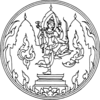Lop Buri

![]() จำนวน : 755,854คน
จำนวน : 755,854คน
![]() Slogan :National Treasures of King Narai’s Palace and Phra Kan Shrine, Famous Prang Sam Yot, City of Din So Phong Marl, well-known Pa Sak Jolasid Dam and Golden Land of King Narai the Great.
Slogan :National Treasures of King Narai’s Palace and Phra Kan Shrine, Famous Prang Sam Yot, City of Din So Phong Marl, well-known Pa Sak Jolasid Dam and Golden Land of King Narai the Great.
Lop Buri province is situated on the western end of the Khorat Plateau and is one of several provinces in central Thailand where many significant historical artifacts and prehistoric settlements have been discovered.
Formerly known as La-Wo or Lavo, Lop Buri is believed to have been an important seat of power in Southeast Asia between the 7th and 14th centuries. Excavations in Lop Buri have revealed that the city was clearly a site of strategic significance, with evidence that the city has been inhabited for over 1,200 years. In fact, relics from as early as the Bronze Age chronicle a history that has seen Lop Buri develop into intriguing city with a blend of both eastern & western influences featuring both ancient and modern attractions.
Lop Buri was first developed into a major town during the era of the Dvaravati Kingdom (6th-11th centuries) when Indian culture was influential to the region. However, most historians believed the first settlers of the town were the Lawa (an ethnic group related to the Mons), which may be the reason for naming the town La-Wo. Around the 10th century the town came under the sovereignty of the Khmers and it became one of their outlying provincial capitals, although some have argued that La-Wo was the capital of an empire that ruled for many centuries until relocating its seat of power to Ayutthaya in the late 11th century.
Regardless, Khmer Mahayana Buddhism was a major influence on the town’s architecture, a style that has since been commonly referred to as Lop Buri Style. Remains of Khmer-Hindu architectural motifs found in the city include the Shiva’s Shrine (Prang Khaek), San Phra Kan, Phra Prang Sam Yot, and Wat Phra Si Maha Tat.
In the late 13th century the Thais, who migrated from the North, fought against the Khmers and declared their independence. Since then, Lop Buri has been ruled by Thai Kings. In 1664, King Narai, a King of Ayutthaya, made Lop Buri the second capital with the help of French architects. Therefore, the architectural style of Lop Buri during the reign of King Narai was half Thai and half western and is best appreciated at his Royal Palace and the Royal Reception House.
The fascinating city of Lop Buri is a unique blend of East and West, ancient and modern, royal splendor and majestic ruins, all of which offer tantalizing glimpses into the city’s alluring history.
Located 155 kilometers north of Bangkok, Lop Buri is unlike many historical cities. Modern day Lop Buri has grown up and, for the most part, enveloped the remains of the old city, which had been a settled by various groups over the centuries. In recent years, Lop Buri was discovered by tourists who were interested in history and culture, and the city now offers a refreshing insight into Thailand is history.
Visitors arriving by road might be somewhat surprised to be greeted by a giant pink wedding cake ‘kratong’ that sits brashly in the middle of a pond at the town’s main roundabout. However, those arriving by rail are given a sneak preview of the history awaiting them in the shape of Wat Phra Sri Ratana Maha Tat, the 12th century ruins of a Khmer temple complex that lies close to the rustic, little railway station.
The temple has several important prangs, parts of which date back to the 10th and 11th centuries and attest to the influence of the Angkorian Khmers in the region.
The town is also overrun with monkeys, most of which take up residence around the ruins where they are honored each year with an enormous feast.
Beware of valuables, including ear-rings and cameras, as the monkeys of Lop Buri are known to steal anything they can get their hands on.The Lop Buri train station has baggage storage if you wish to stop for a few hours and walk to the nearby attractions.


